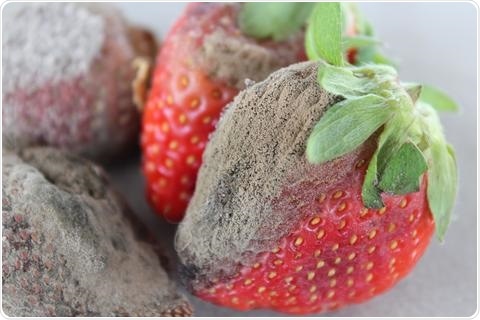A new study has revealed an important phase in researchers’ quest to produce targeted and more eco-friendly fungicides that protect food crops.

Strawberry infected with gray mold, a fungal disease that primarily affects ripening or damaged fruit. Image Credit: Nicole Ward Gauthier/University of Kentucky.
For many years, scientists have known that biological cells produce small, circular structures known as extracellular vesicles. But their crucial functions in the communication between invasive microorganisms and their hosts were understood only recently.
Hailing Jin, a geneticist from the University of California, Riverside (UC Riverside), and her research team have discovered that these vesicles are used by plants to unleash RNA molecules at fungal attackers, inhibiting the genes that make fungi harmful.
These vesicles shuttle small RNAs between cells, like tiny Trojan horses with weapons hidden inside. They can silence pathogenic fungal gene expression.”
Hailing Jin, Professor of Genetics and Cy Mouradick Chair, Department of Plant Pathology and Microbiology, University of California, Riverside
The use of small RNAs and extracellular vesicles offers many benefits over traditional fungicides. They are more environmentally friendly because they are analogous to naturally occurring products. They ultimately decay and do not leave toxic traces in the soil. Jin also explained that this strategy of combating fungi is less likely to breed pathogens that are resistant to drugs.
A stumbling point for researchers in the development of these fungicides was to find ways to load their required small RNAs into the vesicles.
We’ve wondered how these weaponized small RNAs get into the bubbles. Now, we think we have an answer.”
Hailing Jin, Professor of Genetics and Cy Mouradick Chair, Department of Plant Pathology and Microbiology, University of California, Riverside
Jin’s laboratory has found a number of proteins that act as binding agents, helping to choose and load small RNAs into the vesicles. The laboratory’s study has been described in a new paper published in the Nature Plants journal.
For many years, the Jin laboratory has been working on the development of gene-silencing RNA fungicides for many years. Studies performed toward this objective allowed the researchers to make a landmark discovery in 2013 that gene-silencing RNA messages can be transmitted from the fungal pathogen to the host plant to inhibit the immunity of the host. The researchers later discovered that small RNAs can travel both ways—from plants to pathogenic invaders' cells as well.
Then in 2018, the researchers determined that the extracellular vesicles were the main delivery system for these small RNAs. They noted that Arabidopsis plants release extracellular vesicles into Botrytis cinerea—a kind of fungus that causes grey mold disease and kills millions of crops per year.
This was the first example of a host using these vesicles to deliver small RNAs to another organism. Previously we saw movement of RNA but didn't know how the small RNA are selected and transported.”
Hailing Jin, Professor of Genetics and Cy Mouradick Chair, Department of Plant Pathology and Microbiology, University of California, Riverside
Jin and her collaborators have now discovered many RNA-binding proteins in the Arabidopsis plant that attach to certain small RNA molecules and then load them into extracellular vesicles. This indicates that proteins have an important role to play in loading and stabilizing the small RNAs in the vesicles.
The discovery can help boost the payload of gene silencing RNAs that change it into vesicles and improve the efficiency of disease control.
Inspired by RNA interaction in plant vesicles, a few scientists have developed human therapies. For instance, some are trying to load anti-cancer RNAs as well as drugs into extracellular vesicles in vegetables or fruits so that individuals can drink or eat them. Jin hopes that her laboratory’s findings would support these attempts.
Source:
Journal reference:
He, B., et al. (2021) RNA-binding proteins contribute to small RNA loading in plant extracellular vesicles. Nature Plants. doi.org/10.1038/s41477-021-00863-8.